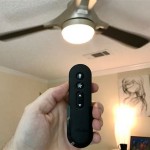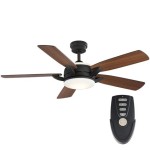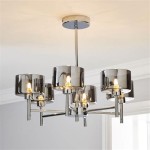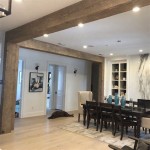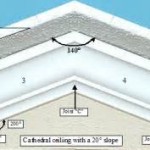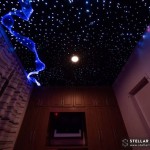How To Install a Hunter Ceiling Fan Without a Light Kit
Installing a ceiling fan can significantly improve air circulation and energy efficiency within a room. While many ceiling fans come equipped with a light kit, there are models designed for use without one. This article provides a comprehensive guide on how to install a Hunter ceiling fan without a light kit, ensuring a safe and functional installation.
Before beginning the installation process, it is imperative to gather all necessary tools and materials. This preparation will streamline the process and minimize potential delays. A standard toolkit should include a screwdriver set (both Phillips head and flathead), wire strippers, wire connectors (wire nuts), electrical tape, a voltage tester, a ladder or step stool, and a ceiling fan mounting bracket suitable for the existing electrical box.
Safety is paramount when working with electrical components. Prior to commencing any work, turn off the power to the circuit that controls the ceiling fan at the circuit breaker. This step will prevent electrical shock and ensure a safe working environment. Use a voltage tester to confirm that the power is indeed off at the electrical box where the fan will be installed.
Key Point 1: Preparing the Electrical Box and Mounting Bracket
The electrical box is the foundation for the ceiling fan installation. Ensure that the existing electrical box is rated for ceiling fan support. Electrical boxes are typically labeled with their weight capacity. If the existing box is not fan-rated, it must be replaced with a fan-rated box that can properly support the weight and movement of the ceiling fan.
The mounting bracket provides a secure attachment point for the fan motor. Hunter ceiling fans often come with a specific mounting bracket designed for their models. If replacing an existing ceiling fan, the old mounting bracket should be removed. The new bracket should be attached to the electrical box using appropriate screws. Ensure that the bracket is securely fastened and level. A wobbly or improperly installed bracket can lead to instability and potential hazards.
When attaching the mounting bracket, align the holes in the bracket with the corresponding holes in the electrical box. Use machine screws, not wood screws, to secure the bracket to the electrical box. Wood screws are not designed to withstand the constant movement and weight of a ceiling fan. Tighten the screws securely, but avoid over-tightening, which can strip the threads or damage the electrical box.
Verify that the grounding wire from the electrical box is readily accessible. This wire will be connected to the grounding wire of the ceiling fan. Proper grounding is essential for electrical safety, preventing electrical shock in the event of a fault.
Inspect the wiring within the electrical box. Ensure that the wires are in good condition and that there is sufficient length for making connections to the ceiling fan's wiring. If the wires are frayed or damaged, they should be replaced by a qualified electrician.
If the electrical box is recessed into the ceiling, consider using an extension bracket to bring the mounting bracket closer to the ceiling surface. This will ensure that the ceiling fan sits flush against the ceiling and prevent any gaps or instability.
Confirm that the mounting bracket is compatible with the downrod length of the ceiling fan. The downrod is the metal rod that connects the fan motor to the mounting bracket. If the downrod is too long, the fan may hang too low. If the downrod is too short, the fan may not have sufficient clearance from the ceiling.
Key Point 2: Assembling the Ceiling Fan Motor and Downrod
After securing the mounting bracket, the next step involves assembling the ceiling fan motor and attaching the downrod. The motor housing typically contains the wiring and mechanisms that control the fan's operation. The downrod provides the necessary distance between the motor and the ceiling, ensuring proper airflow and clearance.
Refer to the manufacturer's instructions for specific assembly details, as different Hunter ceiling fan models may have slight variations in their assembly procedures. Generally, the steps involve feeding the motor's wiring through the downrod and connecting the downrod to the motor housing. Some models may require the installation of a hanger ball, which allows the fan to swivel and adjust to uneven ceiling surfaces.
When threading the wires through the downrod, exercise caution to avoid damaging the insulation. Use a wire puller if necessary to guide the wires through the downrod without causing any abrasions or cuts. Damaged wiring can create electrical shorts and pose a safety hazard.
Once the wires are threaded, connect the downrod to the motor housing. This typically involves inserting the downrod into a designated receptacle on the motor housing and securing it with set screws. Ensure that the set screws are tightened firmly to prevent the downrod from loosening over time.
If the ceiling fan includes a hanger ball, attach it to the top of the downrod. The hanger ball typically has a slot that aligns with a pin on the mounting bracket. This allows the fan to hang freely while the wiring connections are being made.
Inspect all connections to ensure they are secure and properly aligned. A loose connection can cause the fan to wobble or create unnecessary noise. Double-check the set screws and hanger ball to ensure they are properly installed.
Consider applying a small amount of thread locker to the set screws to prevent them from loosening due to vibration. Thread locker is a liquid adhesive that helps to secure threaded connections. However, avoid using excessive thread locker, as it may make it difficult to remove the screws in the future.
Ensure that the downrod length is appropriate for the ceiling height. A general guideline is to have at least 7 feet of clearance between the fan blades and the floor. Adjust the downrod length accordingly to ensure adequate clearance.
Key Point 3: Wiring Connections and Final Installation
With the motor and downrod assembled, the final step involves making the wiring connections and securing the fan to the mounting bracket. This step requires careful attention to detail to ensure proper electrical connections and a safe, functional installation.
Carefully lift the assembled ceiling fan and position it near the mounting bracket. If the fan includes a hanger ball, align the slot in the hanger ball with the pin on the mounting bracket and allow the fan to hang freely. This will free up both hands for making the wiring connections.
Connect the wires from the ceiling fan to the corresponding wires in the electrical box. Typically, there will be a black wire (hot), a white wire (neutral), and a green or bare copper wire (ground). Use wire connectors (wire nuts) to connect the wires, ensuring that the connections are secure and properly insulated.
The black wire from the fan should be connected to the black wire in the electrical box. The white wire from the fan should be connected to the white wire in the electrical box. The green or bare copper wire from the fan should be connected to the green or bare copper wire in the electrical box. These color assignments are standard electrical conventions, but it is always best to verify the wiring with a voltage tester before making any connections.
After connecting the wires, carefully tuck them into the electrical box, ensuring that they are not pinched or strained. Arrange the wires neatly to allow for easy access in the future if any maintenance or repairs are needed.
Once the wiring is complete, lift the ceiling fan and secure it to the mounting bracket. This typically involves aligning the holes in the motor housing with the corresponding holes in the mounting bracket and inserting screws to secure the fan in place. Ensure that the screws are tightened firmly to prevent the fan from wobbling.
Attach the fan blades to the motor housing. The blades are typically attached using screws and washers. Ensure that the blades are evenly spaced and aligned properly. Improperly aligned blades can cause the fan to wobble or create excessive noise.
Install any decorative trim or covers that came with the ceiling fan. These components typically conceal the wiring and mounting hardware, providing a clean and finished appearance.
After the installation is complete, turn the power back on at the circuit breaker. Test the ceiling fan to ensure that it is operating properly. Verify that the fan is running smoothly and that the speed settings are functioning correctly. If the fan wobbles, check the blade alignment and tighten any loose screws.
Finally, double-check all connections and components to ensure that they are secure and properly installed. A thorough inspection will help to identify any potential problems and ensure a safe and reliable installation.

How To Install A Ceiling Fan Hunter

Nothing But Air Choosing Ceiling Fans Without Lights Hunter Fan

Wiring A Ceiling Fan And Light With Diagrams Ptr

Hunter Newsome 42 In Indoor Low Profile Premier Broe Ceiling Fan With Light Kit 51081 The Home Depot

Hunter Sunnyvale 52 In Indoor Outdoor Premier Broe Ceiling Fan 59619 The Home Depot

Ceiling Fans Without Lights Hunter Fan

Hunter Builder Deluxe 52 In Indoor Ceiling Fan With Light Com

How To Install A Ceiling Fan Hunter Company

Hunter Dempsey 52 In Brushed Nickel Indoor Flush Mount Ceiling Fan With Remote 4 Blade The Fans Department At Com

Ceiling Fans Without Lights Hunter Fan
Related Posts


